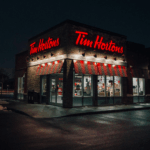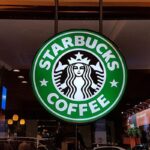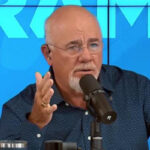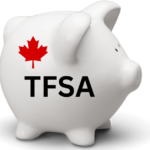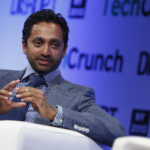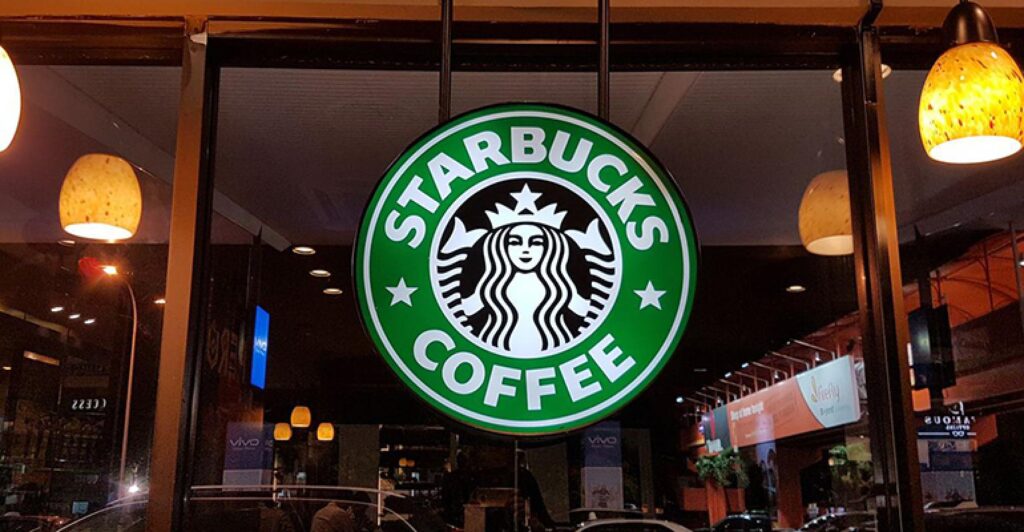
Table of Contents
- The Founders
- Howard Schultz
- Howard discovers Starbucks
- Howard discovers Coffee Bars in Italy
- Il Giornale
- Howard buys Starbucks
- Growth and Expansion
- Employees become Partners at Starbucks
- How Costco helped Starbucks
- The Frappuccino
- Going International
- Adversity
- Present Day
- Real Estate
- Final Thoughts on Starbucks and Howard Schultz
The Founders
Starbucks was founded by Gordon Bowker, Zev Siegl and Jerry Baldwin. They went to school together at the University of San Francisco and fell in love with Peet’s Coffee. Peet’s coffee company was the first real-deal coffee on the west coast of the United States. Peet’s founder Alfred Peet, brought specialty Arabica coffee to Northern California when he opened the doors of Peet’s Coffee in 1966.
The three friends, Gordon, Zev and Jerry, wanted Seattle (their hometown) to have access to this wonderful coffee. They decided to bring specialty coffee in the form of Starbucks, back to Seattle.
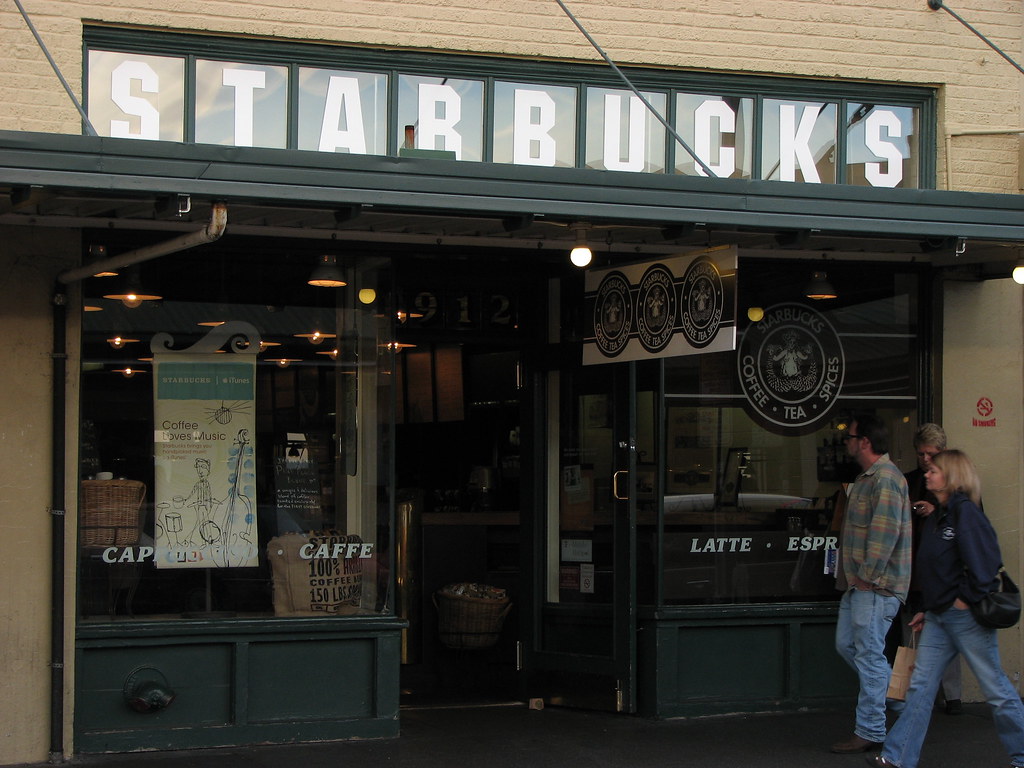
The first Starbucks location opened in 1971 in the Pike Place market. The founders were not roasting their own coffee at this time. They were bringing Peet’s coffee from San Francisco up to Seattle. Peet’s coffee was being sold in Starbucks packaging when they opened the first Starbucks store. Starbucks Coffee Company at this time and all the way up until 1985-86 only sold coffee beans by the pound – there was no beverage in a cup.
Shortly after the original store was built, there was a fall-out between the founders and Zev Siegl left the company. Starbucks was now entirely owned by Jerry Baldwin and Gordon Gowker (Gowker would wind up leaving too, later on). But this story isn’t really about them, it’s about the employee they went on to hire.
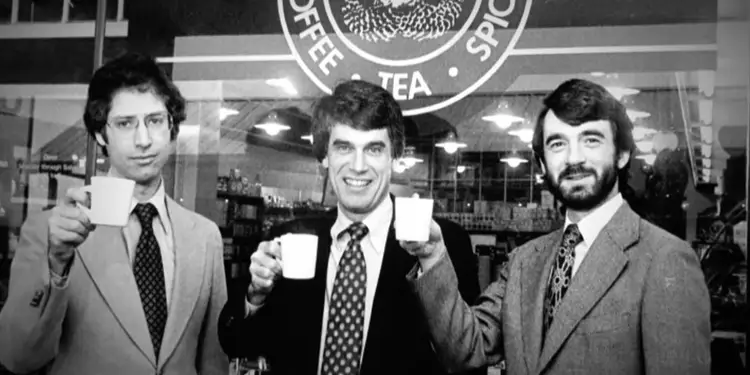
Howard Schultz
In 1979-80 Howard Schultz visited Seattle for the first time.
But before we move on with the story, let’s get to know Howard a little bit.
Howard grew up poor, in the projects in Brooklyn, New York. His family was, as he describes, dysfunctional, more or less due to the pressure of money. Howard’s mind was always imprinted with the memory of how his father felt disrespected, de-valued and vilified as an un-educated, blue-collar veteran. Howard’s father worked a series of jobs and never “made it” financially.
In the mid to late 70s after graduating from Northern Michigan University, Howard managed to land a role at Xerox as a salesman. At this time, Xerox and IBM were what Apple, Google, Meta and the like, are today. At Xerox, he sold word processors (picture a type-writer except with some built in memory to go back and fix mistakes one line at a time).
Howard was given a specific territory he had to work within and the job was to make 50 physical cold calls a day (I guess you could call it door-knocking as well). Hearing him describe this job reminded me a lot of Will Smith’s character in The Pursuit of Happyness. The job taught him about an incredible amount about selling and humility. The rejection he faced on a regular basis was significant to his development. When he started working at Xerox, he was making $1,000 a month while still living at home with his parents.
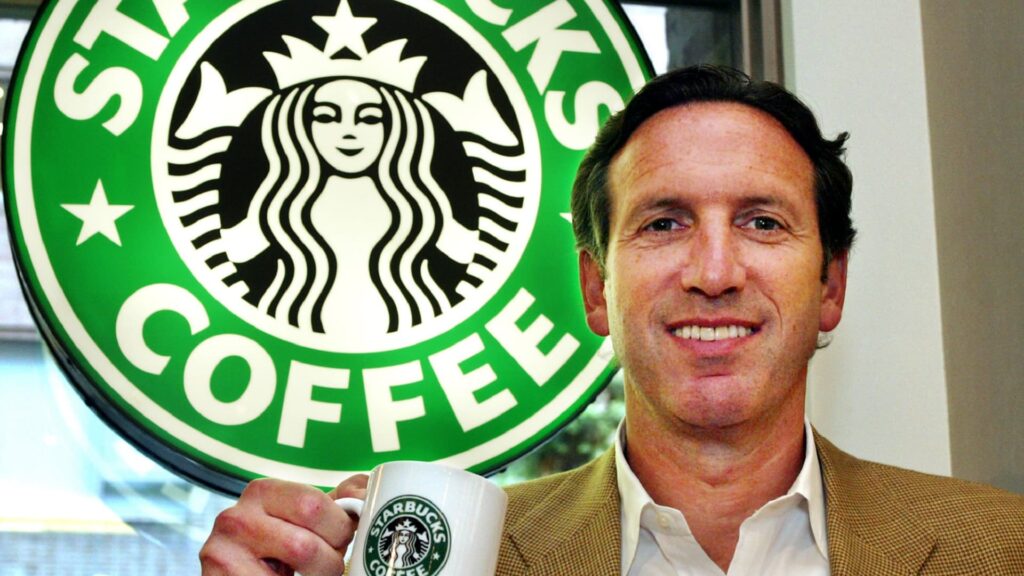
Howard knew that if he stayed at Xerox too long, he would be locked in. Here’s the moment that got Howard Schultz to walk away from a job with the Google of the 1970s:
At the end of the year Xerox gave out performance appraisals. This would be done with a scorecard with a value from 1 to 5. You would have qualitative discussion with your manager and then they would give you a number to summarize your performance. Howard got a “3”. He couldn’t believe it. He had worked all year and he was a “3”.
Howard began putting together other opportunities for himself. He landed himself a role at Hammarplast, a Swedish housewares company. He was the General Manager of the company’s USA office. Hammarplast manufactured a beautiful, non-electric coffee maker (a thermal unit). One of their biggest customers in Northern California was Macy’s. While Howard was on a sales call in California, he heard there was a small company in Seattle, Washington that was purchasing a lot of their product.
Howard discovers Starbucks
Howard went to Seattle to find out what was going on with the large orders of their thermal units. Starbucks was buying the units to sell in their store.
The first time Howard walked into the Starbucks store in Pike Place, he was blown away. He was in awe of the experience, romance of the coffee, the education — it just spoke to him. He became so interested in what Starbucks was doing that he asked if he could meet the owner. One thing let to another and he met with Jerry Baldwin, and they established a vendor-customer relationship over the course of a year. At this time Starbucks had only 3 stores.
Over the next year, Howard became more interested with the possibility of leaving New York City. He and his now wife (Sherry), were dating at the time. He somehow managed to maneuver his way into a job working for Starbucks. The decision was made. He and Sherry drove to Seattle, Washington on Labor Day weekend in their old Audi with their Golden Retriever.
Howard was offered the job of “Head of Marketing” for Starbucks. It was 1982 and they needed to create this role as they were getting ready to open their fourth location. Keep in mind, they were still just selling coffee beans as their sole product — there was no beverage yet.
The Coffee Landscape in early 80s Seattle
When Howard arrived in Seattle, there was another coffee company that existed called Seattle’s Best. However, at the time Starbucks was going above and beyond to educate the customer on what good coffee tastes like. With all the tourists that visited Starbucks, they were able to establish a mail-order business.
This new segment of their business would ship Starbucks coffee beans to tourists in their hometown, so they could consume Starbucks coffee at home. When tourists walked into Starbucks at this time, they would buy a bag of coffee beans and fill out a form that essentially stated “I would like to have this mailed to me in my city because there isn’t anything else like it”.
The coffee bean shelf life was 1 week to 10 days and Starbucks didn’t have a vacuum-sealed bag at the time. To counteract this constraint, Jerry Baldwin made sure the coffee beans were shipped in small quantities. Jerry was big on quality and freshness.
Starbucks had two layers to their business model at this point. First, they had the physical coffee beans they were selling by the pound, out of their four stores. Now, they had added on a mail-order business, shipping their beans all over the United States.
Starbucks was still a small business at this time, but the equity of the brand was a lot larger than the size of the business. Jerry and Gordon were excited about expanding to Portland, Oregon. Howard on the other hand, saw a much bigger opportunity.
Howard discovers Coffee Bars in Italy
It was 1983, and at this time in America, coffee was mainly of the low-quality instant form (think Maxwell House and Folgers). There was nothing interesting about it, except the small segment of specialty coffee. The problem with the non-specialty coffee was that it was made from Robusta beans. Robusta beans became a thing during the war to give the troops fuel to keep going. It was not made for taste.
Starbucks and many other Coffee retailers that you know today use high-grade Arabica coffee beans.
Howard went to a trade show in Milan, Italy as the head of marketing for Starbucks that year. This was his first time in Italy and he couldn’t help but notice one coffee bar after another, on his way to the venue. What he was witnessing was the coffee business, but not the same one that Starbucks was in. He was witnessing coffee being sold as a beverage in stores for the very first time.
When he got back to Seattle, Howard sat down with Jerry and Gordon and told them that what was happening in Italy is what Starbucks needs to be doing. Jerry and Gordon had already been to Italy and seen what Howard had seen. However, they wanted no parts of selling coffee as a beverage.
Howard was not happy about this. He banged on their doors ~ figuratively, for two years and they finally let him open a coffee bar. This was within the 6th Starbucks store. Out of the 1200 square feet, he got 100. He designed and opened the coffee bar and worked behind the counter as a barista. Starbucks typically got 200 to 300 customers a day selling their coffee beans. At this coffee bar, there were 500 customers in 1 week — after introducing lattes cappuccinos and expresso.
After a month of what Howard considered to be a success, Jerry Baldwin was not going for it. He didn’t like it. He told Howard “I don’t want to be in the restaurant business”.
Between 1983 and 1985 Jerry Baldwin, because of his relationship with Alfred Peet, had an opportunity for Starbucks to buy Peet’s coffee company. Alfred Peet was Jerry’s mentor and he was retiring. Jerry thought why not buy the same business, except in Northern California and keep them separate.
Things got a little rocky after this. After acquiring Peet’s Coffee Company, Starbucks got into financial trouble. In addition, between opening the 6th store and Jerry not wanting to repeat the coffee bar idea, Howard grew frustrated. He said he was going to leave Starbucks.
Il Giornale
Howard had no money to open up his own coffee store. Jerry told Howard “Starbucks does not want to open up coffee bars but we will invest in Il Giornale (the company Howard started before Starbucks got into financial trouble). Howard needed to raise 1.6 to 1.7 million dollars to get his dream off the ground. He had gotten the investment from Starbucks, and few other people they knew but was still short to go out on his own.
Howard went to Italy to see two large Italian companies to pitch them his idea. The two companies were the expresso company Faema, and the large Italian coffee company Lavazza. Both of them turned him down. They told him “no one is going to buy Italian expresso in Seattle or America”.
Howard wasn’t about to give up. He went back to Seattle to visit with its three titans of industry – Jack Benaroya, Herman Sarkowsky, and Sam Stroum. They were the leading citizens of Seattle at the time who had invested together in many ventures. Howard pitched them his idea and they told him they believed in him and would provide the remaining investment for Il Giornale.
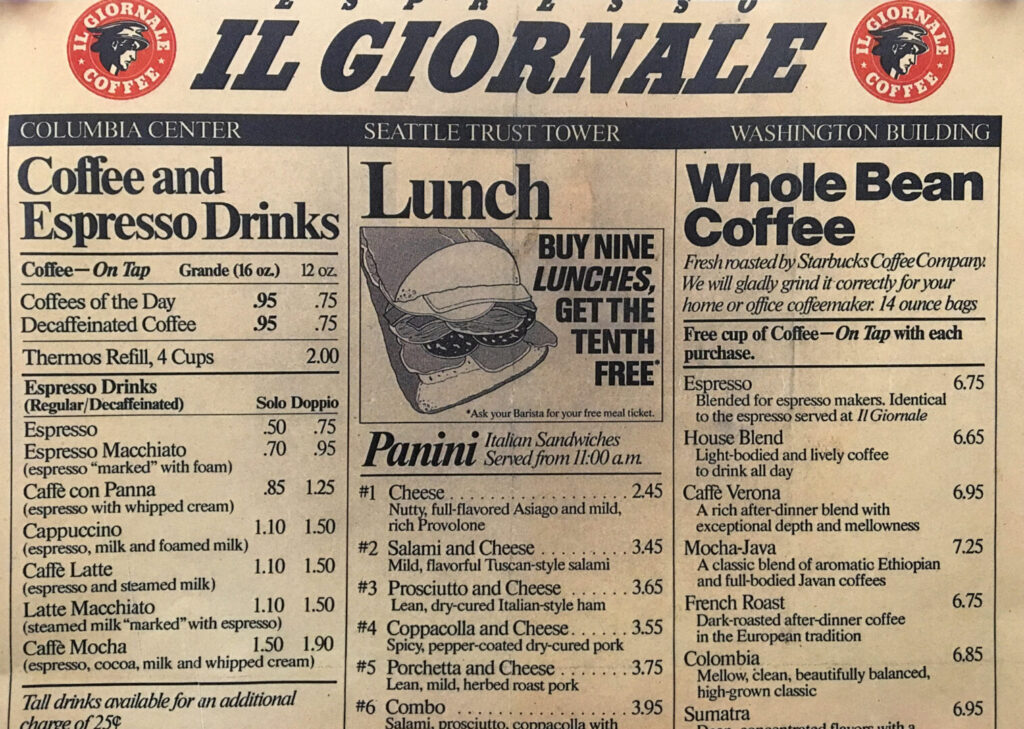
Now that Howard had raised the capital he needed, he was able to open three Il Giornale locations. Two locations were in Seattle and one was in Vancouver, BC. All three locations did well, but Howard didn’t have the money to expand beyond that. Coffee bars were a much better business long-term than selling coffee beans, but more capital intensive. Howard needed to pay for more labor. The stores were not too expensive to open at the time, as they were small (less than 1000 square feet). Howard worked as a barista with a few others to keep the costs down. He didn’t take a salary for almost two years.
Reality Check
Meanwhile, while all this was going on, Sherry was working a full-time job while pregnant with their first child. It was looking increasingly worse for Howard from a traditional perspective – leaving a job and moving across the country and not making any money a few years later.
When Sherry was seven months pregnant, her parents came to visit them in Seattle.
Sherry’s father asks Howard to take a walk with him and tells him “whatever you’re doing, I respect it. But it’s not a job, it’s a hobby. You need to get a job. My daughter’s pregnant, she’s working and you’re not.” Howard started crying at this point.
He came home in the afternoon completely shook. After his in-laws went to bed, he was sitting with Sherry and was trying to tell her what had happened with her father. Sherry was already angry with her father. She told Howard “there’s no way we’re turning around, we are going to keep going”. Sherry was the glue to everything that happened from that point onward, for Starbucks.
Howard buys Starbucks
After Howard got his coffee bars going, Starbucks was still in financial trouble. They had a debt to equity ratio of 6 to 1 for such a small company. Jerry Baldwin came to Howard and told him that he and his wife were moving to California. They were going to keep Peet’s Coffee and sell Starbucks.
Jerry: I think you’re the person to buy Starbucks
Howard: That’s fantastic, but I don’t have any money. How much is it?
Jerry: 3.8 million dollars
This conversation happened in 1986-87. Jerry gave Howard 90 days to raise 3.8 million dollars to buy Starbucks. Around the second month, Jerry came to him and asked him “where are you with all of this”. He lied a little bit and told him he had about half of the money raised (he was a little short of half). Jerry tells him that one of his investors put in an all cash offer on the table (with no due diligence) and wants to close right away.
He told him who it was and as soon as he heard the name he knew it was over. Howard was part of a basketball league and was playing that night at the Seattle Club. After the game he began crying to his good friend Scott Greenberg and telling him what had happened. Scott was an attorney at a prestige law firm in Seattle. Scott told Howard to come into the office the next morning and tell the story to their senior partner at the firm.
Howard met with the senior partner the following morning. It was Bill Gates Sr. Yes, that Bill gates of Microsoft – his father. Howard told Bill Sr. the whole story and Bill responds with “Howard I’m going to ask you two questions”.
Bill Gates Sr: Is everything you told me true?
Howard: Yes
Bill Gates Sr: Have you left anything out?
Howard: no, that’s everything
Bill Sr. tells Howard to come back in one hour. Howard leaves with Scott and comes back in an hour. When he comes back, Bill Sr. tells Scott he wants to talk to Howard alone. Before Howard sits down Bill Sr. tells him they’re going for a walk. They go to Rainier Tower in Seattle and visit Sam Stroum’s office. Yes, Sam Stroum was the mystery investor trying to buy Starbucks. They walked into Sam’s office and Bill Sr. leans over to the desk of Sam Stroum and says the following:
I don’t know what you’re planning, but whatever it is, it’s not going to happen. Howard Schultz is going to acquire Starbucks Coffee Company and he’s never going to hear from you again.
Bill Gates Sr.
Howard didn’t have the money. He didn’t understand what just happened. Bill Sr told Howard “You’re going to buy Starbucks Coffee Company and my son and I are going to help you”. That was how Howard Schultz purchased for 3.8 million dollars in 1987. Bill Gates Sr never mentioned publicly or took credit for helping Howard buy Starbucks.
When the acquisition was official, they had three Il Giornale locations already, just bought six Starbucks stores, and two were under construction. By the end of the calendar year in 1987, Starbucks had 11 stores and 100 employees. Howard and company now had the stores, the brand name and the roasting facility.
The ability to source and roast coffee, putting it through the supply chain of a beverage, resulted in an 80% gross margin. This was far greater than the restaurant business. In addition, Howard chose the first 500 locations himself.
Growth and Expansion
At the 1988 shareholder and employee meeting Howard highlighted how Starbucks operates, and delivered his vision for the future of Starbucks.
We focus on our people. The people delight the customer. The customer satisfies the shareholder.
Howard Schultz
You have no idea what we have here, this will change America — this can become America’s coffee house.
This company since 1971, has been growing at a very very slow pace. As a result of that, when you combine Il Giornale and Starbucks together — we’re going to take your 6 stores you built in 17 years, and go to 26 stores in 1 year and over 100 stores in 5 years.
Chicago
What he said about how quickly Starbucks will grow, sounded crazy at the time, but it’s what ended up happening. Starbucks was not without competition. There were regional coffee bar competitors that were franchising, like in Chicago. This allowed them to grow at a much faster pace than Starbucks. Starbucks did not employ the franchising model. Howard has said that unlike McDonald’s which is a commodity business, Starbucks is an experiential business and should not be franchised.
Howard visited Chicago in 1987-88. Chicago was the first major market Starbucks was in, outside of Seattle and Vancouver. The business didn’t take off right away in Chicago. One of his new partners, Howard Behar, went to Chicago and fixed it, staying through the winter and recalibrating the mistakes they were making there.
Howard Behar joined Starbucks in 1989 and was the man behind the idea of “servant leadership” and “nothing else matters if we’re not people first”. Howard Schultz was the visionary but Howard Behar made sure the operations were running smoothly. Behar trained all the operators and built the operating system of Starbucks. He also created the system to handle the flow of customers.
There was a third member of the team at this point, Orin Smith. Howard called him “the adult in the room”. Orin was quiet and the only one with an MBA in the company. He was the wise man who could say something like this behind closed doors: “we’re not doing that and you’re both full of sh*t”. The two Howards would listen to him when he called them out like that.
Los Angeles
Once Starbucks was up and running at optimal levels in Chicago, Howard (Schultz) wanted to expand to LA. There was conflict between the team at this point. Behar wanted to go to San Diego and felt they weren’t ready for LA. Howard Schultz could see what Behar couldn’t. He could see that that equity of the brand was so big that everyone would walk around with Starbucks cups in the warm weather. It was true they weren’t ready, but they did it anyway.
When Starbucks entered Los Angeles the business took off right away because the celebrities embraced it. Starbucks did not intend to be a luxury brand. The team wanted Starbucks to be accessible to everyone. In any given Starbucks line, there would be the CEO of a company and the person behind him would be a blue collar truck driver. At the time, everyone could afford the luxury of Starbucks. Howard describes this luxury as: quality of coffee, experience, the badge of walking around with the cup.
Employees become Partners at Starbucks
Howard grew up in a family with no health insurance and saw what that did to a family. In 1988 Starbucks rolled out health benefits to include part-time employees and gay couples in domestic partnerships. This benefit plan was the first of its kind. At the time Starbucks only had 33 stores.
It was important to Howard to build a company that went above and beyond to provide its employees with respect and dignity. This all came from his upbringing in a dysfunctional household. He wanted to crack the code on how to create employee benefits that exceeded the expectations of their employees. The team would have discussions early on about “how do we exceed the expectations of our people so they can exceed the expectations of the customer”. The first time they were able to manifest this was the year before their IPO (became a publicly traded company on the stock exchange).
In 1991, Howard wanted to give equity in the form of stock options to every single employee in the company. They ended up giving 14% of everyone’s base pay in the form of stock options. Howard made sure to do it the year before the IPO so the employees wouldn’t miss it. The program was called Bean Stock (great name right?) and it provided equity in the form of stock options to anyone working 20+ hours a week. It was the first time in history something like this was offered.
This was the turning point in the culture of Starbucks — the day they announced this and all employees became partners in the business. Starbucks was now up to 55 stores and had expanded to Los Angeles.
How Costco helped Starbucks
Jeff Brotman (Costco co-founder) had actually invested in the 1987 round to buy Starbucks. That was when Howard met Jeff. Jeff became an early board member of Starbucks and one of Howard’s biggest mentors. Jeff introduced Howard to Jim Senegal (the other Costco Co-founder). The decision to sell Starbucks coffee beans in Costco came from Howard sitting with Jim and Jeff and talking business. The “people” of Starbucks were against this decision when they first heard of it. Howard did it anyway. You see a pattern here?
Howard was unsure of how Starbucks coffee beans would fare in Costco. He was up front about this to Jim and Jeff. They told him to meet them at a Costco parking lot in Kirkland on a Sunday morning. When Howard arrived they said to him, “look at the cars, those are your customers”.

This was huge for Starbucks. Putting Starbucks in Costco allowed them to directly measure the increase in volume of stores on the east coast (because Costco had stores all over the United States). This was a result of the proximity to the Costco store. To be clear, they were selling Starbucks coffee beans in Costco — not the beverage. The brand awareness of people buying Starbucks coffee beans in their local Costco, meant that those people travelled to Starbucks in the west coast.
Starbucks introduced thousands of beverage consumers to Costco just by selling their beans in Costco and eventually went nationwide. Starbucks was building a beverage business but going back to their core business (selling coffee beans) with new channels of distribution (Costco, grocery stores, etc.) to capture the beverage dollars and customers for their high margin coffee bar business.
The Frappuccino
Boston
It was the early to mid 90s and Starbucks was continuously expanding. They were now in Seattle, Vancouver, Chicago, LA, Portland and Washington DC. But in Behar’s opinion, they were not ready for New York. Instead, they chose to enter the market of Boston. Boston already had coffee bars. They had a high quality competitor by the name of Coffee Connection. Coffee Connection was founded by George Howell who was like the Alfred Peet of the east coast. Boston, of course also had Dunkin’ Donuts.
Starbucks acquired Coffee Connection, similar to how they did Peet’s Coffee Company. They solicited George Howell’s help and advice to validate what they were trying to do. This ended up being a good strategy. Coffee Connection already had a lock on all the best real estate with the best foot traffic. They had already spent the money to figure this out, so it was a no-brainer to acquire them rather than trying to compete.
The acquisition went through in 1994. Starbucks paid 23 million dollars to acquire Coffee Connection. In exchange, they received 23 operational Coffee Connection locations, producing 16 million dollars a year in revenue. Most importantly however, they received the trademark on the word “Frappuccino” that Coffee Connection owned.
The Frap Story
By 1995 Starbucks was up to 500 stores but not yet well-known on the east coast. They now owned the trademark on the word “Frappuccino”. A “frap” was the first blended cold drink that Starbucks had ever introduced. The beverage was all the rave in southern California. The drink was reformatted by a store manager at one of their California locations, before Howard knew the drink had to be bottled and sold.
Howard flew to Atlanta (Coca-Cola HQ) and New York (Pepsi HQ) in the same day. The Coca-Cola meeting lasted less than 30 minutes and they dismissed him. Coke didn’t understand what Howard was drinking to do with the “Frappuccino”. They didn’t even give him much time to explain it.
He then went to New York and met with Roger Enrico and Craig Weatherup of Pepsico. Craig Weatherup, after writing the agreement down on a napkin, shook hands with Howard, forming a multi-billion dollar business. It was a 50/50 joint-venture partnership between Pepsico. and Starbucks for the bottled Frappuccino.
The Frappuccino did so well that the instant it hit store shelves, they had to pull it all off. They needed to remove the product to create new manufacturing processes and factories to make enough to satisfy demand. At this time, there was no other bottled coffee on the market. The year after the Frap launched, it comprised 7% of Starbucks’ total revenue.
Going International
Japan
Howard took a couple trips to Europe and Asia to get a sense of what the international opportunity would be, and how they would accomplish it. He quickly wrote off Europe because coffee bars were already there, so he took that off the board. They quickly narrowed their focus on Japan. Japan had a few thousand coffee stores named Doutor. It was quite a successful coffee chain.
Howard told the board “we have to go to Japan”. The board was resistant. They wound up hiring a consultant to go to Japan and do a study to determine if Starbucks should enter Japan. The consultant returned with a large book of reasons why Starbucks could not possibly succeed in Japan. Among those reasons were:
“the economics won’t work”
“no one in Japan would walk in the street with a cup of coffee”
“your no smoking policy (which existed from the beginning) is a non-starter”
“you cannot afford the economics (the rent) in Japan”
This made Howard furious and more intentional about entering Japan.
One day, they received a hand written letter from a Japanese company. Its founder had a restaurant in Los Angeles and was enamoured with Starbucks. They weren’t ready, but decided to give it a shot anyway (shocker). The team went to Tokyo to meet the Japanese founder and formed a joint-venture partnership with him. Starbucks believed that any country they entered where the population didn’t speak English, they should enter with a partner.
Grand Opening
The grand opening of their first Japan store happened on a humid August day in Tokyo. There were about 200 people in line. Howard couldn’t believe it. These people didn’t even speak English. After Howard cuts the ribbon to symbolize that the store is now open for business, a young man raced inside. He appeared to be a college student who slept in line overnight to be the first person to enter. When he approached the counter he said “double tall latte”. Howard once again, couldn’t believe it.
Japan was an extraordinary success for Starbucks from the first minute. In a few months, Starbucks coffee cups were all over Tokyo. They now have approximately 2000 stores in Japan and a roasting facility. By 1997 Starbucks had crossed 1000 stores globally.
China
Starbucks entered the market with a partner in China. However, it didn’t work out because the partner didn’t share the company’s values. They ended up buying them out and all the stores in China became company owned. Starbucks struggled in China for almost a decade. They lost a lot of money and there was tremendous pressure inside the company to close the stores in China.
It was rough, until Howard discovered Belinda Wong. Belinda was an extraordinary operator and had great touch with people. Howard credits Belinda 100% for turning things around in China.
Adversity
In the year 2000 Howard took a step back and assumed the role of Executive Chairman — he handed the role of CEO to Orin. Howard’s kids were getting older and he had already missed a lot. He was physically and emotionally exhausted. He had a lot of confidence in Orin so he wasn’t worried. Howard was still engaged in the business, just not the day-to-day operations.
At this time, Starbucks had 3,500 stores and was doing 2.2 Billion dollars in revenue.
Orin eventually transitioned the role of CEO to Jim Donald. It didn’t work out with Jim and Starbucks was now in some trouble. The 2007-2008 financial crisis was upon them and Starbucks was 7 months from being insolvent. The market cap of Starbucks dropped from 30 billion to 7 billion dollars. Growth began to slow. Howard needed to come back as CEO.
Howard returned to the helm of Starbucks in January of 2008. He had to make the difficult decision of closing 1000 Starbucks stores and held a company-wide meeting. Howard started crying and apologized to everyone because they had to close stores and lay people off. There were stores that shouldn’t have been opened and weren’t performing (while Howard was not in charge). Howard was afraid Starbucks would get acquired by someone else and made a last-ditch effort to save the company.
In the wake of Hurricane Katrina, the Starbucks family went to New Orleans and committed to community service in the 9th ward. The next day, they walked through and built a tutorial on how to restore the business and held classes. On the third day, Howard made a speech at the basketball coliseum in front of 10,000 people. He told them the truth, that in seven months they would be insolvent. He had a formula of how many additional customers each store would need to bring in to turn things around. It was 10-11 additional customers per store, per day.
Things turned around in less than a year. In 2008 Starbucks had profits of 315 million. By 2010, they were up to over 900 million dollars in profit.
Present Day
Technology
Starbucks began taking orders and payment manually, using paper. Today, 33% of Starbucks orders are submitted on smartphones using the Starbucks app. But where did it begin?
Adam Brotman and Stephen Gillett came to Starbucks with the idea of building out a mobile app. The app came out in 2009 as Starbucks was early to the app store (The apple app store became a thing in 2008). Howard gives all the credit to Adam and Stephen for assembling the pieces around the app and convincing Starbucks to fund it. He didn’t know what they were going to create and didn’t understand, until he saw it.
In Howard’s opinion, the mobile app is the biggest achilles heel for Starbucks. Sure, it has created unbelievable convenience for customers. However, Starbucks is an experiential brand. The app was seductive for the company to grow at such a rapid pace. The mobile app was beginning to deteriorate the experience at Starbucks. The app was the primary vehicle to place an order, but also the primary vehicle for customer dissatisfaction. People couldn’t get their drink on time.
There was one scenario where everyone in Chicago got off the train at the same time at 8am. The app tells everyone who ordered on the app the same thing, “your drink is going to be ready in seven minutes”. When everyone showed up all at once, it became a mosh pit of people. This was not the Starbucks Howard built.
Real Estate
Roasting Facilities
Starbucks has six roasting facilities (or Roastaries) throughout the world. They sit in Seattle, Chicago, New York, Tokyo, Shanghai and Milan. These facilities were the biggest entrepreneurial, creative project for Howard. Willy Wonka and the Chocolate Factory was Howard’s favourite movie as a kid. He invited the most creative people in the company to his house and turned the movie on.
They went to work on designing a space, but realized that, economically this was a tough business model. They were trying to create an experience that was accretive to the brand and would elevate Starbucks. A 30,000 square foot space in Seattle was created. It was dynamic, possessed the entertainment vehicle of theatre while still encompassing romance and seduction. The facility opened to great reviews. They were manufacturing and roasting coffee in the space which was open to the outside world (similar to what Willy Wonka did with chocolate). Starbucks received approval from the Chinese government to build one just like it in the centre of Shanghai.
But of course, the shrine had to be in Milan, Italy.
Milan
Starbucks’ joint-venture partner in Italy was the Percassi family, headed by the retired Italian footballer Antonio Percassi. The Percassi family is big in the real estate business. Howard was travelling back and forth to Milan as he was being shown various properties by the Percassi family. He kept telling them “this is not the right site” for the roasting facility, time and time again. He kept travelling to see each listing as he needed to see and touch the property.
Then it hit him. He was standing on the corner of Cordusio square (Piazza Cordusio) and he looked up at a space and said “what about that”?
Percassi Family: that’s the post office. You can’t get it.
Hoawrd: well, it’s empty
Percassi Family: You can’t get it
Howard: Can I meet the landlord?
Percassi Family: Howard, it’s the government
Howard: well, who’s responsible for it?
Long story short, the Percassi family arranged a meeting of Howard and the broker involved with the Post Office. Howard finds out that the real story is that the government buildings were sold to private equity firms during the financial crisis. It turned out the owner of the empty post office was Blackstone.
Howard says to himself “why am I Italy” and phones up his good friend Jonathan Gray (Global Head of Real Estate at Blackstone). John became a big fan of Starbucks when he was in Seattle for an event. He had seen the roastery in Seattle and knew exactly what they were trying to do with the space.
Howard: Hey John, I’m in Milan, Italy. Do you realize you own this space in Cordusio square that used to be a post office?
John: Let me check.
Howard: I’m coming to meet you.
They end up doing the deal with Blackstone to acquire the space for their prime roasting facility, situated in Milan.
Starbucks has 30 traditional locations in Italy. They are spread out among Milan, Rome and Florence. Two to three years after they entered Italy, the number one beverage became the expresso at Starbucks. Italians were now choosing to get their expresso at Starbucks versus local shops. Starbucks had respected the Italians and their from 1983 to present and now it has come full circle.
Final Thoughts on Starbucks and Howard Schultz
Regardless of what you think of Starbucks, it was never intended to be a luxury brand. Howard Schultz and company were always focused on the customer experience and the quality of the coffee. They were the first privately-owned U.S. company to offer a stock option program that included part-time employees. They were also one of the first to offer full health benefits to part-time employees and coverage for domestic partnerships.
In 2014, they introduced the Starbucks College Achievement Plan. Starbucks implemented this program to address the growing cost of higher education in the United States, as it has increased by over 500 percent since the mid 1980s. The program creates an opportunity for eligible U.S. partners to earn bachelor’s degrees through Arizona State with full tuition reimbursement. The plan expects at least 25,000 Starbucks partners to graduate through this program by 2025.
All of the above mentioned initiatives were brought on by Howard Schultz or the culture that he instilled in the company. The partners (formerly referred to as employees) always come first. Treating them well and providing them benefits that surpass their expectations is what leads to retention, less training of new-hires, and a better overall experience for the customer.
Howard Schultz currently has a net worth of approximately 2.8 billion USD. He built an empire on the principles of treating employees in an exceptional manner. In addition, he provided health care and equity in the business to Starbucks partners (formerly called employees) which was lacking in all the jobs that he saw his father in growing up. He didn’t need to do this. He could have built a specialty coffee business just like the others. Starbucks stands alone at the top mainly due to what it has done and continues to do for its employees, in my opinion.


